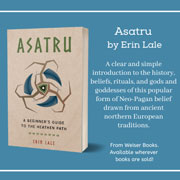PaganSquare
PaganSquare is a community blog space where Pagans can discuss topics relevant to the life and spiritual practice of all Pagans.

I was in for some surprises in May of 2006, when I first visited Samos, a Greek island near the border with Turkey, to give a talk at a students’ club. I had been invited by Minas Papageorgiou—a student back then and now a writer, researcher and journalist—to speak about Mary Magdalene. He took me on a journey up a stream named Potami (pron. potámi), the Greek word for river. It turned out to be a magical place as the stream runs through a forest and forms small lakes and waterfalls.

Who says pop culture doesn't matter? This week for Airy Monday we took at the ways that pop culture, society, and religion all interconnect. Read about the connection of Mad Max: Fury Road to the Morrigan, popular subversions of fairy tales, and how the political intrigue of ancient Greece compares to Game of Thrones. All this and more for the Pagan News Beagle!

Greek Hymns Honoring the Divine Feminine
The Orphic Hymn to Nature brings to light the age-old Mother Goddess of many names, the supreme Creatress, “dancing with whirling noiseless feet” her eternal dance of life and growth. It’s hard to find a more telling description of the Divine Feminine’s immense powers in all of the Hellenic literature!
-
 Ms. Meenee, As someone with Neoplatonist leanings, I am glad that you are making people more aware of the Athanassakis translatio
Ms. Meenee, As someone with Neoplatonist leanings, I am glad that you are making people more aware of the Athanassakis translatio -
 If and when I ever delve into Orphic writings, Athanassakis is the way to go. I own his Homeric translation and it's superb.
If and when I ever delve into Orphic writings, Athanassakis is the way to go. I own his Homeric translation and it's superb.

It's Monday here at the PaganNewsBeagle, the day we celebrate the Element of Air. Today we have academic research on Harry Potter, the linguistics of sacred space, how culture influences auditory hallucinations, and a grisly discovery that's attributed to ancient Germanic rituals. Enjoy!
Does reading Harry Potter books make kids less prejudiced about immigrants? This article details recent social science research that suggests the answer.
...















